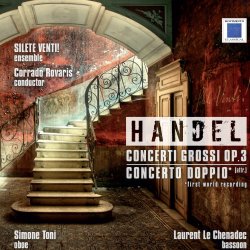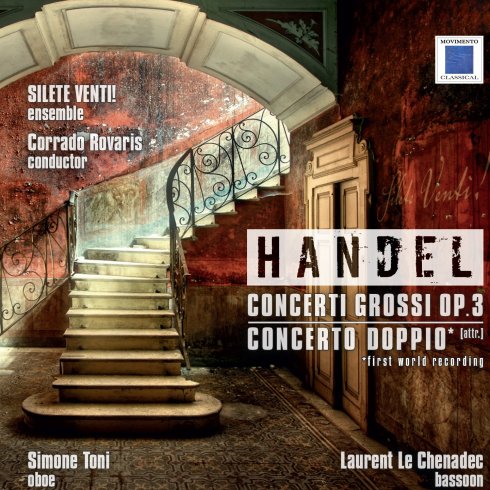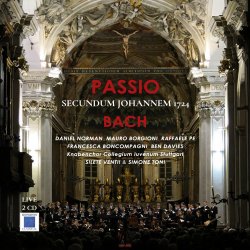

Concerti Grossi Op.3 - Concerto Doppio
GEORG FRIEDRICH HANDEL: an oboe and the adventures of a rare manuscript
"[. .. 1 the oboe... for which [said hel I wrote like crazy a large amount of music.. was my beloved instrument [. .. l " 1
Although in the extensive and diversilied musical catalogue ol George Friedrich Hande l, vocal music plays undoubtedly a dominant role, the instrumental area (be it orchestral, chamber music, or for harpsichordl stands out as a constant presence, a red ribbon that ties a series ol masterpieces such as the well-known Organ Concertos or the Concerti Grossi ol the Opus 3 (published in 1734) and the Opus 6 (1740) to the pillars represented by the Water Music (Suite 1, 1715) and the Music for the Ro ya l Fireworks (1749).
Even il Handel had never written any vocal music, these works - music for dance, opera overtures, and various sonatas ol excellent quality - complete a landscape that would be sufficient to place the name ol the Saxon composer among those ol the greatest musicians ol all time. Beside the works mentioned above, all weil served by musicology, press and even the music industry, there is a series ol scores (some questionable, some certainly genuine) not weil known to the public and also neglected by the specialists' research. Among these we will mention, and not by chance, at least three concerti in which the oboe soloist is the leading instrument. Two were printed in 1740 (composed in the key ol B flat, we can find thematic materials related to the Chandos Anthems). The last one (in G minorl was published late in 1863, reporting 1703 as the date ol compo sition. 2 Within opera Handel also alten gives special attention to the oboe. This lavorite instrument is alten elevated to the rank ol strumento concertante. lt is the undisputed star ol the Opus 3, which has alten been called "Con certi for the oboe" since the middle ol the eighteenth century. The Concerti Grossi ol the Opus 3 were published in London in 1734 by the publisher John Walsh. The collection had a very curious genesis: at that time, Handel was the most fashionable composer in Lond on, and the music written in the ltalian style was very popular in England following the success ol the school ol Corelli and its standard-bearer there, Francesco Geminiani. Walsh asked the Saxon composer to devise a collection ol concerti designed for a market increasingly eager for pieces composed in the ltalian style. Pressed by his commitments, as always, Handel delivered into the hands ol his publisher a bundle ol manuscripts with various origins, some probably written in Florence rather than in Rome, during his langest ltalian stay. The editing ol the pieces was apparently made by the publisher himself. In order to reach the canonical number of six scores, the first edition contained also a composition of an unknown author: the Concerto No. 4, subsequently replaced by an original of the Saxon composer. This was a common practice at the time and should not shock us in any way. Besides, this does not detract from the sublime charm of these high ly inspired pieces, created by one of the greatest musical geniuses of all time. In these, the knowledgeable will recognize immediately the (seif-) quotations from the operas, the oratorios, and even the sacred and spiritual music of the Saxon. The same feeling applies from the very beginning of the wonderful Double concerto for oboe, bassoon, strings and bassa continuo (Concerto doppiol that is offered here in the world premiere recording. The splendid manuscript, preserved in Kiev, ascribes with certainty the authorship of the work to Handel, bearing these words an the title page: "Concerto doppio di Signore Hände l". In fact we have no definite information about either the date of its composition, or the authenticity of the attribution.
The score, says Simone Toni, the author of the discovery, was part of a great German music collection (probably the one at the court of Frederick the Great of Pr ussial , which was plundered by the Russians alter their invasion of Berlin, at the end of World War 11, like many others, such as the Sing-Akademie zu Berlin, that was recently ret urned. 3 Therefore , along with many other works of art, the music attributed to Handel took the road of the Soviet Union, passing unnoticed in the turbulent last years of war. After its arrival in Kiev, with bureaucratic precision and contempt for the elementary rules of conservation of manuscripts, our Double Concerto was stamped an all its sheets of paper and then carefully boxed, waiting for more than sixty years until some scholar could return it to the concert halls. The first performance an original instruments in modern times highlights its freshness, as weil as the striking ingenuity of the themes and the mastery which leads an expert hand to envision dense dialogues between the two soloists, who are required, in the fast te mp i, to display a virtuosity which tests even the most experienced performers.
The formal conception, with four movements, and the orc hestra , whose structure closely resembles that typical for the Roman school of the early eighteenth centu ry, lead us to place the score in the years when Handel was in lt aly. There is no document showing the composition of this work by the Saxon, and as the title page is the only source to suggest him as the author of the Double Con certo, we must refrain from granting the Saxon an undoubted authorship of the wor k. Nevertheless, one is struck at first hearing by its rhythmic tension and by the extraordinary virtuosity demanded not only of the soloists , but also from the whole ensemble.
All th is , together with the compos er's ability to expose the themes with such memorable clarity that can immediately assert themselves to the memo ry, are characteristics which justify including this work unknown as yet among the jewels of instrumental literature of the eighteenth century.




